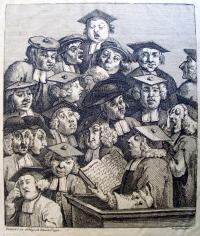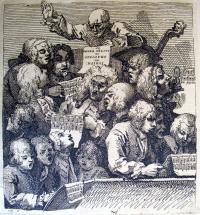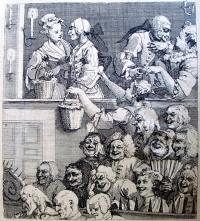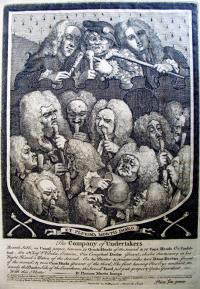William Hogarth (1697-1764), Four Groups of Heads (Scholars at a Lecture, Chorus of Singers, Laughting Audience, and Company of Undertakers), 1737. Engravings. Graphic Arts, GC113 William Hogarth Collection. Gift of Dickson Q. Brown, Class of 1895.
Two of these four engravings by William Hogarth began as subscription tickets for the sale of other prints or groups of prints. Each were printed and sold separately but after a few years, Hogarth cut off the bottom of the plate (where the text about the sale was engraved), reprinted them, and bound them with two additional prints. The four small sheets were then sold under the title Four Groups of Heads. Princeton is fortunate to have both the later printing (1737) and, in some cases, impressions of the original prints.
A Chorus of Singers (also known as Rehearsal of the Oratorio of Judith), was originally a subscription ticket for Midnight Modern Conversation. The print shows a rehearsal of the oratorio Judith, written by William Huggins with music by William Defesch. It was performed February 16, 1733, at Lincoln’s Inn Fields, after a postponement due to the misconduct and pretended sickness of Cecilia Young, who had engaged for the part of Judith.
The Laughing Audience, was originally a subscription ticket for Southward Fair and The Rake’s Progress. Note that only one man is not laughing. He is usually identified as the critic, who were always made to stand in the pit of the theater.
In Scholars at a Lecture the open book reads “Datur Vacumm” (Leisure time is given for…), which according to Ronald Paulson is a pun on ‘vacumm,’ carried out in the expressions of the various auditors. These are scholars at Oxford, wearing square-topped cloth and felt hats, which were worn by all undergraduates and graduates except Doctors of Law, Medicine, and Music.
For more see Ronald Paulson Hogarth’s Graphic Works (London: Print Room, 1989). GARF ND497.H7 A35 1989Q




Thanks for this. In that last picture, the person top middle (Sarah Mapp the bone-setter*) was to reappear, drawn almost identically, in Caulfield's 'Remarkable Person' from 1820. To his credit, Caulfield notes Hogarth had been there before him.
*not sure if she is mentioned by name in the text at the bottom of the print: it's a bit too small to decipher accurately.